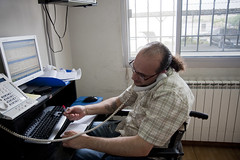This column has a simple purpose but a difficult goal--discuss issues that affect the lives, well-being, and state of mind of those who must live and cope with a disability and do so in a humorous way. Not an easy thing to do, since there is certainly nothing funny or humorous about having a disability or in the obstacles that those with chronic disabilities encounter daily (I've had multiple sclerosis [MS] for 40 years and use a wheelchair). However, I've personally found that humor has, to a great extent, helped me cope with my disability, and I hope this column helps others with disabilities to do so as well.
[ILLUSTRATION OMITTED]
It would be a gross understate-ment to say that I'm "technologically challenged." "Technologically inept," as my sons repeatedly remind me, is a more precise characterization of my (in)ability with today's gadgets. Terms such as "iPhone," "iPad," and "iPod Touch" mean little to nothing to me, a person who's still trying to figure out how to operate the remote control for the TV (that I've had for three years).
A recent conference here in San Diego put on by Cal State University Northridge--the International Technology & Persons with Disabilities Conference--really shocked me out of my electronic malaise and opened my eyes to the many ways today's tech advances can help individuals with disabilities.
Technology Designed for People with Disabilities
In the first demonstration at the conference, a man who was blind demonstrated his use of an iPhone 4S by holding it close to his ear and placing his finger over the phone's display screen. The smartphone voiced the particular application his finger was above. The man then scrolled through other applications, a description of each similarly being read to him, until he found the application he wanted. He then simply tapped the app to open it.
This smartphone allowed the man to use a touch screen without the necessity of a keypad and without having to buy other costly software.
Other Innovations
Other technological innovations demonstrated at the conference included the following:
* Eye-Pro GS Eyegaze from Words+. This technology permits individuals, who do not have the use of their arms or hands, to use a computer by moving a cursor with eye movements and without a mouse. To accomplish this, a small camera is installed on a magnetized base just about where the keyboard would be on a standard PC. The user then performs a calibration procedure, usually with the help of a technician, by staring at dots in different areas of the monitor screen until the dots turn green. The user then selects something either by staring at it for several seconds or by blinking hard. Cost: $7,480.
* Topaz XL HD Magnifier by Freedom Scientific. This is a high definition desktop video magnifier that provides sharp, magnified images of print of all sizes. The magnifier is sold with its own 17-to-24 inch screen and software that allows users to view magnified images on their computer monitors. Because it can be difficult for a user to find their place on a page when working at high magnification, the topaz magnifier contains a Find button that allows the user to zoom out for an overview of the page. Crosshairs allow the user to center the section of interest, and a release button then zooms the user back in to their working magnification level. Cost: $2,195 to $3,695.
* Proloquo2Go Software from AssistiveWare. This software enables people with autism, or who have difficulty verbalizing, to communicate by tapping symbols that are contained on small tiles. Sentences are then verbalized in natural-sounding adult or child voices. For instance, if the user wants to communicate "I am happy to see you," he or she would touch six tiles: the first being a stick figure pointing to itself (for "I"), the second being an equals sign (=) (for "am"), the third being a happy face (for "happy"), the fourth being a red arrow pointed to the right (for "to"), the fifth being a face with an arrow pointing to the eye (for "see"), and the sixth tile being two stick figures pointing to each other (for "you"). This app is loaded on an iPhone, iPod Touch or iPad. Costs $190.
* PlexTalk Pocket DAISY Player PTP1. This pocketsized gadget is a DAISY (Digital Access Information System)-compliant music, voice, and book player/recorder that's designed for people with vision impairments or dyslexia. It features a high quality built-in microphone for easy DAISY structured voice recording, and voice memo recording capability to help users remember telephone numbers, appointments, "To Do" lists, etc. An additional built-in large speaker allows playback of voice recordings, voice memos, DAISY audio books, text-based DAISY books and MP3's. Playback can be accessed from the External USB Drive, as well as using the Embedded Text-To-Speech Engine. Cost ranges from $275 to $350.
* Human Information Management Systems Braille Edge 40. This is a keyboard display that is linked to a personal computer, smartphone or tablet wirelessly using Bluetooth. Designed for the blind and visually impaired, it also helps users manage their daily activities by taking advantage of a built-in Notepad, Scheduler, Alarm & Clock, and Calculator. This is a new product. No pricing for it has as yet been released.
Levinson, Jerry
Source Citation
Levinson, Jerry. "Technology and people with disabilities." The Exceptional Parent Apr. 2012: 56. Psychology Collection. Web. 24 Apr. 2012.
Document URL
http://go.galegroup.com/ps/i.do?id=GALE%7CA287391748&v=2.1&u=22054_acld&it=r&p=PPPC&sw=w
Gale Document Number: GALE|A287391748


No comments:
Post a Comment